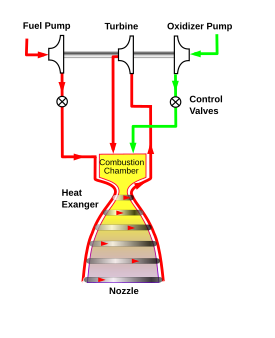
The expander cycle is a power cycle of a bipropellant rocket engine. In this cycle, the fuel is used to cool the engine's combustion chamber, picking up heat and changing phase. The now heated and gaseous fuel then powers the turbine that drives the engine's fuel and oxidizer pumps before being injected into the combustion chamber and burned.
Because of the necessary phase change, the expander cycle is thrust limited by the square–cube law. When a bell-shaped nozzle is scaled, the nozzle surface area with which to heat the fuel increases as the square of the radius, but the volume of fuel to be heated increases as the cube of the radius. Thus beyond approximately 300 kN (70,000 lbf) of thrust, there is no longer enough nozzle area to heat enough fuel to drive the turbines and hence the fuel pumps. Higher thrust levels can be achieved using a bypass expander cycle where a portion of the fuel bypasses the turbine and or thrust chamber cooling passages and goes directly to the main chamber injector. Non-toroidal aerospike engines are not subject to the limitations from the square-cube law because the engine's linear shape does not scale isometrically: the fuel flow and nozzle area scale linearly with the engine's width. All expander cycle engines need to use a cryogenic fuel such as liquid hydrogen, liquid methane, or liquid propane that easily reaches its boiling point.
Some expander cycle engines may use a gas generator of some kind to start the turbine and run the engine until the heat input from the thrust chamber and nozzle skirt increases as the chamber pressure builds up.
Some examples of an expander cycle engine are the Aerojet Rocketdyne RL10 and the Vinci engine for Ariane 6.[1]
- ^ "Ariane 6". www.esa.int. Retrieved 21 February 2017.